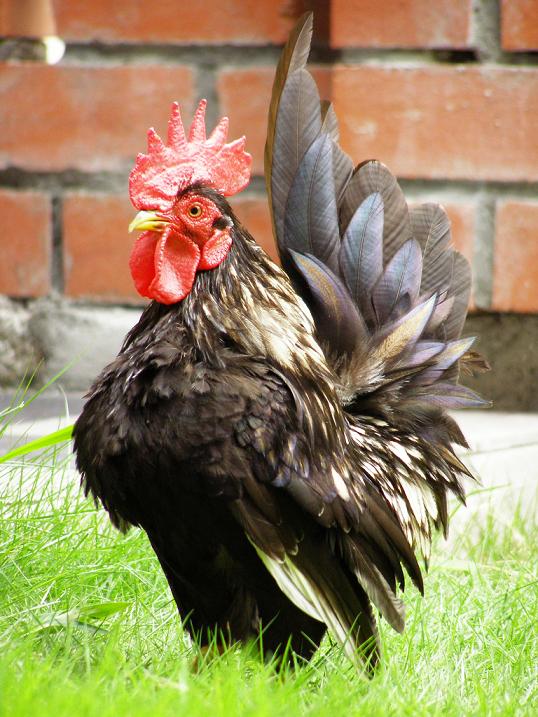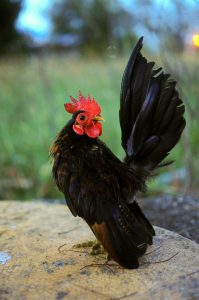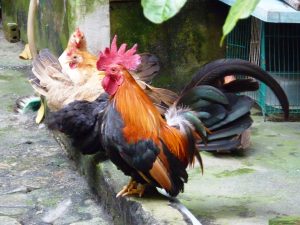
Breed Overview
The incredible Serama are infact the smallest breed in the world! Thought to be bred from Japanese Bantams, jungle fowl and possibly Silkies.
How big are Serama chickens?
Believe it or not the males stand just 6 to 10 inches (15-25cm) off the floor, and weigh only 12 ounces (340g)!
Breeders have had to divide the Serama into three classes they are shown below.
How much do Serama chickens weigh?
Class A Cock 12oz (340g)
Hen 11oz. (310g)
Class B Cock 17oz (480g)
Hen 15oz. (425g)
Class C Cock 20oz. (570g)
Hen 17 oz. (480g)
Given their uniqueness they were only imported into the United States in around the year 2000. In their native Malaysia they are so small most people keep them indoors in their apartments! Are you looking for a breed that can be kept indoors?

Eggs
Size
Small
Color
White
Production per year
50-80 per annum
When do they start laying eggs?
From 18 weeks. Serama mature early from about 16-18 weeks. They lay all year round.
Serama Characteristics
Temperament / Are they good as pets?
They make fantastic pets and have a very calm docile temperament. Their temperament is similar to Silkies. Males with other males can be a bit aggressive to each other however. Most people keep Seramas in the house. People treat them much like a cat or dog. They will moult all year round however dropping a feather or two a day. They really do thrive on human interaction too. Id say that because of this they need a little bit more care and attention than other chicken breeds. They are so great with children of all ages. They would make a brilliant first pet for kids.
How do I tame Serama chickens?
Well this isn’t hard. They are so friendly and will very quickly become used to their owner and will even sleep on you. So a great breed if I want a cuddle in the evening from your chickens!
How many do I need to buy?
Id recommend purchasing in twos. However a small of flock of 6 birds is a great size. There will be squabbles between males, usually over a female but nothing too serious.
How much space do they need?
Keeping Seramas indoors
Most people keep them indoors giving them full access to the property. To thrive they need to be in a environment above 15°C. If keeping them indoors they require their toenails to be cut fairly regularly. This is to prevent their nails getting stuck in the carpet, pillows or rugs.
Keeping Seramas outdoors
With this breed they will need less space, as they are the smallest chicken breed. Id recommend 7sqft per Seram a as a minimum. They must have a perch and a dust bath to clean in. They will need half a foot in space on the perch per bird. Throw in some treats and toys for them to play with in the coop and run to keep them entertained. They don’t like the cold if you live in a cold region you will have to place a heat lamp or something to keep them warm. If the weather is bad outside it would be good practice to have somewhere inside to take them. Somewhere that’s dry, warm and obviously free from nasty parasites.
Will they mix with my other chickens?
Yes they will mix well with other bantams and smaller sized breeds. I don’t mix the larger breeds with the smaller breeds. As there can be bullying that occurs. I also don’t mix my docile breeds like Silkies with other very active lively birds. Again for the same reason I found bullying occurred from the larger birds.
Appearance
Well amazingly they appear in almost any color. Yes you heard me right. There are literally thousands of different colors of these birds in Malaysia. There is no standard color either within breed clubs and owners.
They are very recognizable, by their upright posture and have a full muscular ‘pumped up’ breast. The tail feathers are go vertically up and look spectacular on such a small bird. They is no space between the tail feathers and the body.
The wings are quite large in proportion to the body. Seramas keep their wings held in a vertical position. They should be just clearing the ground and the feet will be partially visible.

Feeding
What should I feed them?
Any chicks will need to be eating chick crumb sometimes called starter crumb. They will eat this to upto the stage of 6 weeks of age. Normally at 6 weeks they are moved into growers mash i’d avoid growers pellets or anything pelletised with Serama chickens. They can find pellets too large and can choke. Even bantam pellets can be too big for the small Serama.
After 16 weeks normally chicken would onto layers pellets, again I wouldn’t do this with Seramas. Feeding them layers mash is much better for them. Layers mash contains all the correct nutrients they will need to start egg production.
How much should I feed them?
They’re cheap to rear, Seramas consumes only about 1lb (455g) of feed each month. In the summer months when its hotter than the usual, they may even consume less than that and this is normal.
What can’t they eat?
All chickens shouldn’t eat certain things, no matter the breed. The leading causes of Serama deaths from food is chocolate and beans. Did that surprise you? Chocolate is harmful to chickens and most animals infact, like dogs. Chocolate contains ‘theobromine’ which causes cardiac arrests in chickens. The beans, and infact dried beans are the worst offender, contain phytohemagglutinin which again causes fatalities. So be extra specially careful if you feed your Serama leftovers as that’s where beans could creep into their diet.
What do I need to keep chickens?
Ok I’ve knocked together a shopping list for Serama chickens
Coop needs to be slightly smaller with good ventilation but need to be warm. If your keeping them inside id still recommended a smaller wire pen with a cage so they can roost properly.
Food is simple better stuff is here, along with a feeder shouldn’t set you back too much.
A waterer is a must, I wouldn’t use a bowl from the kitchen, they can fall in it and will poop into the water. Plus if they get in they will have wet feet either walking round your property they will ruin floors with marks. Or if they in a coop they will get the bedding wet with wet feet. Or they might knocked over the water bowl, this a happens a lot, and then the coop will go moldy and rotten. Enough said, a good waterer will last years.
